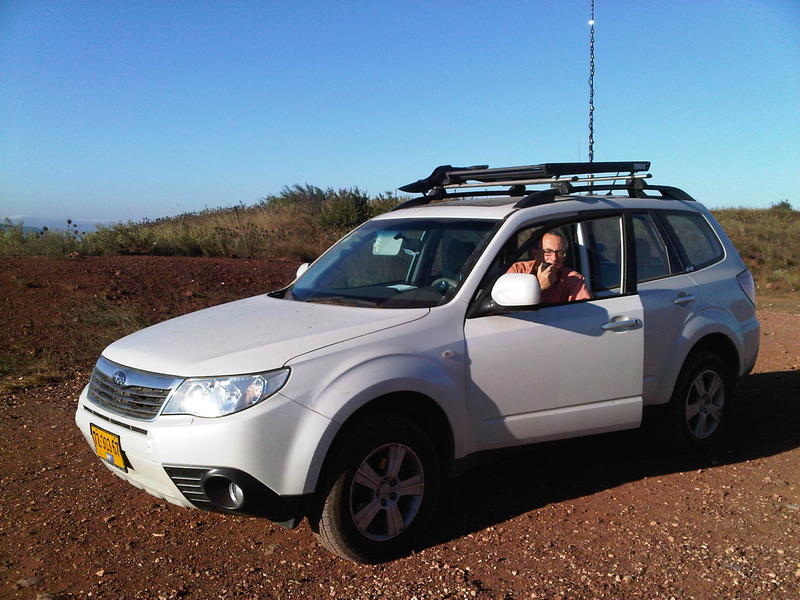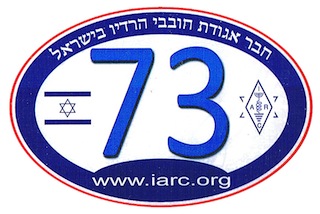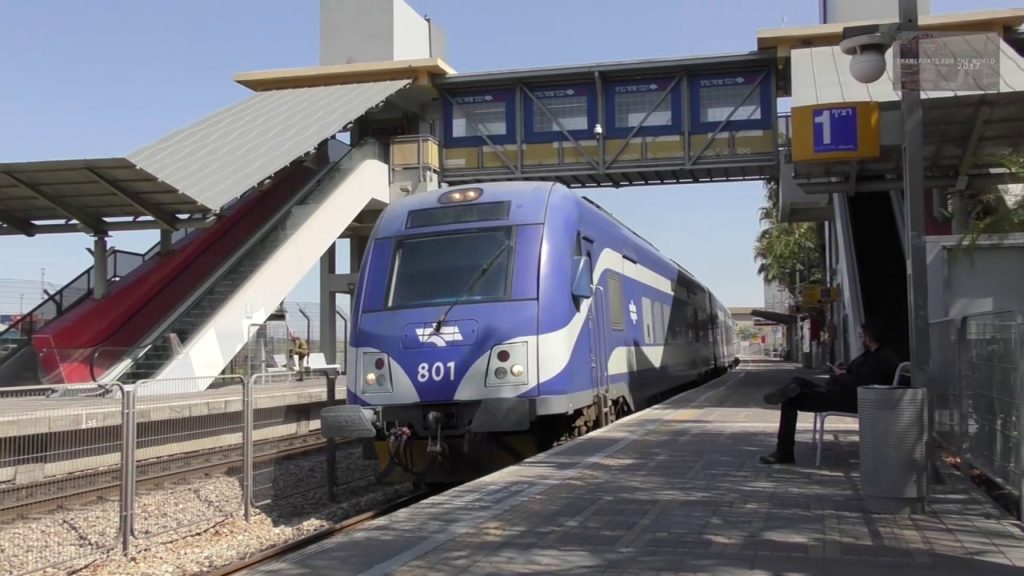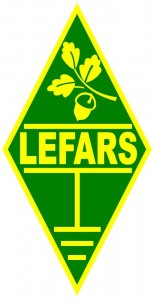Amateur Radio in Israel.
During a recent trip to Israel I could not resist the opportunity to do at least a bit of Ham Radio.
After finding a group on Facebook called Israel Ham Radio, I left a message saying I would be visiting and would anyone fancy meeting up!
I was quickly contacted by Amos Sobel 4X4MF who invited me to Haifa where on a Tuesday morning Hams from all over the North of country meet for a regular breakfast coffee and a chat in a cafe opposite Lev-Hamifraz train station.
The trip did not start out that well however, as I had been suffering from what seemed to be a sinus infection which kicked off an Asthmatic Cough. Whilst on the plane this developed into a full on eye infection. I spent the first day in Israel with my eye nearly gummed shut which meant a visit to the hospital the following morning for a full workup of Cardio Monitor, blood work and an X-Ray and a referral to an Ophthalmologist. One bottle of steroid eye drops later and £280 later we are on our way!
We were based at Hadera, which is half way between Tel Aviv and Haifa, which was a great place to travel to the Northern parts of Israel. It was also where a family wedding was taking place, which was what the primary reason for our visit was, so it was convenient for the event and some exploring.

Oded Sela from Tel Aviv, out mobile. Sadly I never did catch up with him on this visit, but will be staying in touch for future visits!
Battling to get healthy I noticed I had another invite, this time from Oded Sela 4X6AV, who invited me to meet up if I made it to Tel Aviv. He wanted to show me the station that he had help put together at Tel Aviv University, and yes have an obligatory coffee.
As it turned out, my communication with Oded got lost in Facebook Messenger along the way, so I could not arrange the University visit in the limited time we had, but I was all set for the Tuesday meet in Haifa.
I planned the journey carefully. I manage to download an app from Israeli Railways with all the routes and timetables on it. It had a handy route planner, which told me that there was a fast train which left Hadera that would get into Haifa Lev-Hamifraz train station in Haifa at about 9:00am right on time for the meet in ‘Café Café’ opposite the station. I managed to get a taxi to the station in time which cost about £10, the train cost about £12 using a Rav Kav card, which saved me a few pounds over an ordinary ticket & allowed me free bus access for the day. I watched the big display board for my train & sure enough it was scheduled and on-time, and then about 3 minutes it was due to come into the station, a notice came up and then it promptly disappeared from the display. After finding someone to speak English, I discovered that the train had been cancelled. I then had to frantically work out an alternative train which would only go on another two stops and then I would have to change to another train.. Then my original train popped up on the screen again.. Yes it is back on again, but wait a train came into the station and I jumped on, only to find it was the slow train that stopped up a few stations..
I got off the train in Binyamina and watched as the fast train came through the station at a fair lick, the one I should have got on back in Hadera. I then had an extended wait for the next train to Lev Hamifraz.
I arrived at my destination exactly 1 hour late and expected to get to the café to find everyone gone. The walk from the station was really quick. The exit went into a medium sized shopping centre which had a good range of shops and food stalls, and there it was Café Café. All I had to do was look for a number of radio amateurs. How would I recognise them? Well as it turns out, it was quite easy. There was a group of about 25 guys (mostly of whom seemed of pensionable age) with a few tables pushed together in the corner of the Café. I wandered over and was welcomed by Amos Sobel who had invited me, and he ushered me round to get a chair and squeeze in around the table with Yechiel Poleg 4X4OE, who was volunteered to speak English to me!
As it happens, I was lucky his English was good, much better than my (non-existent) Hebrew. Yechiel explained that this meeting was held regularly in Haifa on Tuesday mornings. I made the observation that it was a strange time of day for a meeting, but he replied, “but we are all retired.. all except him (pointing out a chap in his 40’s), so it is easy for us to meet in the day.”.

Poleg Yechiel 4X4OE’s Shack. Poleg who obviously had the best English was assigned to be my primary host.
It appears that Radio Amateurs in Israel have had a tough time for some a while. Not only is the licensing regime quite strict but taxes have made imported radio gear prohibitively expensive, and many people have to think ‘outside the box’ in order to get around issues. An example is that they can buy aluminium no problems, but if they were to import an aerial, because it has a coil in it, it is classed as electrical equipment and attracts a heavy import tax. Homebrew is quite popular when it comes to aerials and towers, but there is the odd importer of radio gear, including one in Haifa which imports Icom gear. Yechiel was quite proud of the tower that he had made to his own spec by a local metalworker, including an insulated bearing for luffing the tower over. Most of his aerials are homebrew and his main radio is a trusty old Kenwood 440S. I showed him pictures of my shack and aerial farm and we discussed the similar issues we face regarding planning. He said that it now becoming a big issue in residential areas in Israel. Zoning as they call it in the US is causing radio amateur grief in Israel, but they do find ingenious ways to get around the rules. You are not allowed a mast over 8m for an aerial, but it is OK for ‘meteorological equipment’. The answer is simple.. just bolt on an anemometer and you are good to go.
One area which is causing more concern is the public complaining about high RF emissions being a health issue. Some members of the public have complained that their health is being affected by the signals put out by Radio Hams. With that in mind the Israeli Authorities have put together a form that you have to put on the frequencies you are using, the output power of your radio (along with supporting documentation form the manufacturer, feed line losses, plus the gain of aerial system and the then using that information calculate the EMF in uW/cm2. The Israeli standard is that the public should not be exposed to more than 10% of ICNIRP (400-1000uW/cm2) or 1% of ICNIRP in schools. If you pass this standard, your station gets a certificate of compliance which has to be renewed every 3 years. Now to be honest, this only ever seems to be an issue if a member of public brings it up, and then you have to jump through hoops, but it is a good reason to keep your neighbour sweet!
Amos Sobel came over for a chat.. He took great delight in telling me about his Flex Radio setup and his burgeoning interest in FT8. He explained that he could run 4 different contacts at a time on his SDR, which sounded quite impressive.

Amos’s shack showing multiple FT8 sessions running on his Flexradio SDR. Amos’s Mix of Vintage and Modern was quite interesting. Just because modern tech is is expensive in Israel, it does not mean no-one can afford it!
Chatting with the guys was quite challenging. The deficiencies of our understanding each other’s languages meant that some things did not translate easily. It was quite funny though how when discussing what was talked about on the radio, it very much mirrors what we talk about here.. Radio, equipment, getting round the red tape (which they blame us for by the way! Apparently we introduced the officialdom that they inherited during the British Occupation known as the British Mandate). They also talk about their health , which is unsurprising as they have an ageing membership and are finding it a challenge to attract ‘Young Blood’ to the hobby. The new Radio Station at Tel Aviv University is a step in the right direction though, and I have to say I was really disappointed not being able to visit it, but perhaps next time.
The guys in the cafe started to drift away after putting the world to rights for nearly 3 hours and had to get ready to get a bite to eat and travel back on the train.
Did I do any Radio while I was there? Well, not really. I had a VHF /UHF handy with me, I had the software on my iPad which showed me the nearest repeaters and their settings, but like a total idiot, I left the radio’s programming cable at home. After several attempts to program the radio via the front panel which ended in failure due to the tricky programming procedure for Baofeng, I gave up! To be honest the trip was so short, i did not have a great deal of spare time to operate anyway, but I was in reasonable distance of at least three repeaters whilst staying at Hadera, but I will definitely be better prepared next time I visit the Holy Land. DMR wise I discovered that slot one on all DMR repeaters in Israel are set to the national talk group and a multitude of others are on slot 2 on demand. All of the repeaters are on the Brandmeister system, there is no Phoenix presence there at all.
Reciprocal licensing is easy.. Israel has signed up to CEPT, so anyone with a full licence can rock up, stick a 4X/ in front of their call sign and crack on.. Just make sure you have a copy of your license with you. You can operate for up to 4 months on the reciprocal license agreement, after which you are expected to apply for an Israeli license.
Operating in Israel is quite easy, but be careful about what equipment you take, You might want to make sure that the radios you take with you have type approval for Israel.. I am not sure how you do that, but it is worth chatting with someone on the Israeli Hams page on facebook for a heads up.






1 Response to Ham Radio in the Holy Land:- Dave De La Haye, M0MBD Visits Israel